How to trade Options – Trading tutorial for beginners
Table of Contents
Ideally, every investment portfolio comprises several asset classes to reduce risk. Just like stocks, mutual funds, ETFs, and bonds, options are also an asset class. What makes options interesting is that they offer several advantages that other asset classes don’t – when used appropriately.
Before we address these benefits and get into how you can make money with options, let’s understand what options are and how they work.

What is an Option?
An option is a contract that empowers (but doesn’t require) you, the investor, to buy or sell an asset at a predetermined price over a period of time. The underlying asset may be a security, an ETF, or even an index. Options are bought and sold on the options market. Only contracts based on securities are traded on the options market.
To understand how they work, you will need to understand two terms: strike price and premium. The strike price is the price at which you agree to buy or sell an underlying asset. The fee you pay for trading an option is the premium. The premium is a percentage of the asset’s value, and it influences your profits in some ways we highlight later in this post.
Premiums have two components: the intrinsic value and the time value. The difference between the strike price and the share price is the option’s intrinsic value. The time value is calculated by considering the time to expiration of the contract, the interest rates, the stock’s volatility, and many other factors. These two components can help you determine whether an option is a good investment. As a trader, you must learn that options are a lot more than just contracts. They belong to a large group of securities called derivatives. As the name suggests, derivatives are assets whose price is derived from the price of something else. By extension, the price of options is also derived from the price of another asset. While options are similar to stocks in some ways, they are fundamentally different. Stocks represent ownership in a company, while options only give you the right to buy or sell an asset at a specific time.
Note:
Options also resemble futures, since futures also use contracts. However, since you cannot withdraw from a futures contract, they pose a higher risk.
What is Options trading?
Options trading involves trading options contracts on the options market. It is typically done with securities on the stock or bond market. Some traders also trade options on ETFs and the like. A trader can only buy or sell an option via a brokerage. E*Trade, Ameritrade, Robinhood, and TradeStation are some of the most popular brokers.
Options have different time frames and can expire monthly, bi-monthly, quarterly, and so on. The typical options contract lasts for six months and expires on a Friday.
Why trade Options?
Options are considered a powerful financial instrument that can enhance a trader’s portfolio. Besides allowing the trader to make additional income, options can also give them leverage and protect the trader’s money. Regardless of your current circumstances and financial goals, there is likely an option out there that can help you meet your goal.

Here are a few more benefits that add to the appeal of trading options:
- Diversity: Getting your hands on an option is a lot cheaper than buying a stock, and an option gives you several opportunities to make money. Since your capital lasts longer trading options, the profit potential is high.
- Higher profits: When a stock’s price changes, you can make a lot more money with an option. Let’s say the price rises from $50 to $100. If you had the stock, you would make a 100% profit. However, if an option you bought at $1 rises to $5, you would make a gross profit of 500%. You can make a lot more money in a much shorter period with an option.
- Low cost: Purchasing an option works out a lot cheaper than buying the underlying asset (for example, a stock). In essence, with options, you can control the same number of stocks with less capital. Furthermore, if you decide to day-trade with options, you will benefit from entering and exiting positions faster and with less risk.
- Better chances of success: Since you aren’t obligated to exercise your option, the chances of you losing significant amounts of money is low. The volatility of options can often lead to profit.
Why trade Options rather than direct assets?
One of the biggest advantages of options is that a trader can construct options strategies flexibly. You can decide to buy or sell just a single option or make a complex strategy involving multiple option positions.
The CBOE offers options in a wide array of stocks, ETFs, and indexes, meaning there is never a shortage of opportunities to profit.
Drawbacks of Options trading
Just like stock and bond trading, options trading also involves risks. The speculative nature of options trading puts you at substantial risk of loss. But besides the risk that options trading poses, there are a handful of other challenges every options trader must overcome:
- Price movement reductions: As you begin to trade options, you will notice that the price movement of the option is limited by the time the premium lasts. The loss of time value can wear away at the gain in the asset’s price. If you are day trading, though, the time value of your trade options will be relatively restricted.
- Vast bid-ask spreads: The bid-ask spreads of options are often a lot wider than those of stocks. The biggest reason behind this is the lower liquidity of the options market. Fluctuations as tiny as half a point can affect the profit of your trade.
While these disadvantages can and will affect your profit potential, they shouldn’t dissuade you from trading options. As long as you bear the risks and nuances in mind and tailor your trading tactics per requirement, you won’t have trouble making profits.
Types of Options
Options can be complicated and pose a high risk. However, there are only two main classes of options: put options and call options.
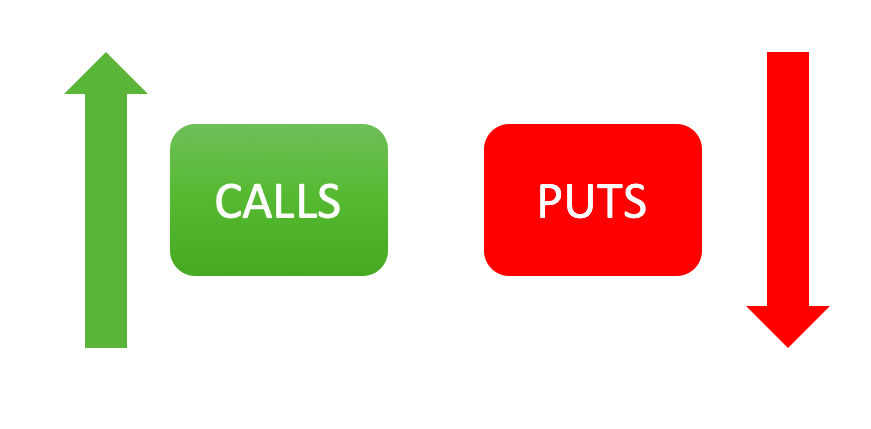
Call Options
Call options are contracts that give you the right to buy an agreed-upon number of shares, typically 100 shares per contract, of a commodity or security at a specific price over a specific time. In simpler words, with a call option, you can buy a specific number of shares of an ETF, a stock, some bonds, and even indexes at a future time.
When buying a call option, you want the asset to rise in price. Since you will be buying the stock at the current price sometime in the future, you can purchase the stocks and sell them immediately to make money if the price goes up. Remember that you will need to pay a fee to buy options called a premium, as discussed earlier. You can think of the premium as a down payment for your stocks or other underlying assets. The options contract you get will expire at some point – at which point you have the choice of renewing them. Options must typically be renewed on a weekly, monthly, or quarterly basis.
If the stock price doesn’t go up, or you are waiting for it to rise higher, you will need to keep renewing your options to retain the right to buy the stocks at the same price. The renewal cost increases the total amount you invest into the stocks, which in turn reduces the potential profit you will make. This is called time decay. The value of your options contract will decrease over time.
Note:
The lower the strike price of the call option, the higher the intrinsic value of the option.
Put Options
Put options are contracts that give you the right to sell an agreed-upon number of shares, typically 100 shares per contract, of a commodity or security at a specific price over a specific time. Contrary to the call option, this contract gives you a right but not an obligation to sell a security or commodity by the expiration date. For your put option to make money, the price of your underlying asset must fall. You could also sell the put option if you think the price of the asset will go up.
Note:
The higher the strike price of a put option, the higher the intrinsic value of the option.
Terminology you need to know
“Out of Money” and “In the Money”
The strike price of whatever asset you’re trading is determined by the price of the underlying asset. Let’s say the current value of the stock you’re buying an option on is $100. If you’re trading call options, any strike price above the stock’s value is called “out of money.” Strike prices below it are called “in the money.”
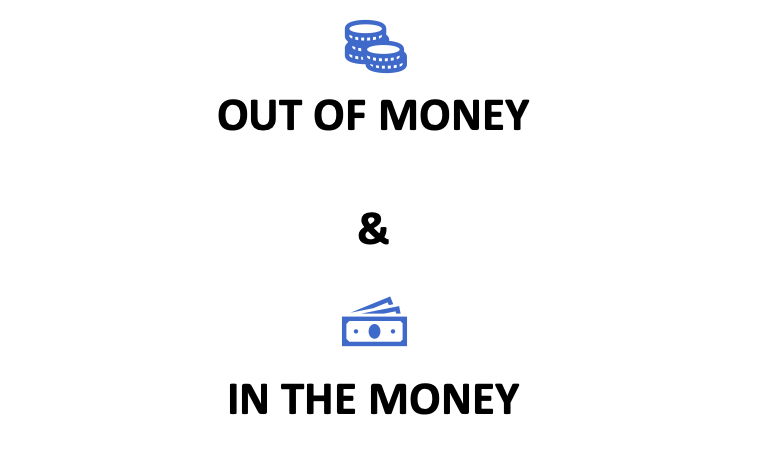
The opposite is true for put options. If the strike price is lower than the stock price (in this example, $100), the strike price is called “out of money.” Strike prices above $100 will be called “in the money.”
Here’s why you need to know about these terms:
“Out of money” options are worth nothing at expiration – whether you’re trading call or put options. You always want the strike price to be “in the money.”
“Long” and “Short” Options
A long trade is a trade where you buy an asset expecting it to rise in price, so you can sell it off and make money. On the other hand, in short trades, you sell the asset first to buy it at a lower price later and make a profit. Options trading is typically “long” trading. You will likely get an option hoping that the price of the underlying asset will go up.
Even if you buy a put option, which gives you the right to sell the security, you are still purchasing a long option. Furthermore, while you could short or sell a put option, the profit you make will be limited to the premium you paid. With time, you will need to pay higher and higher premiums. While there’s a chance you will make money, you’re taking an unlimited risk as you continue to pay the premiums.
Holders and writers of options
The people that buy options are called holders. The people that sell options are called writers of options. While the difference between them may seem simple, learning the ramifications of the roles they play is critical. Buyers, which are the call and put holders, do not have to buy or sell anything. They only risk the premium they spent, and if the trade doesn’t go their way, they don’t lose much money.
On the other hand, sellers, or call and put writers, are obligated to buy or sell if their option expires “in the money.” A seller may need to deliver on the promise of buying or selling an option and be exposed to unlimited risk in a lot of cases. In this way, writers of options can lose a lot more than the premium price.
How to start trading Options
Options trading may seem simple; however, it requires knowledge of advanced trading strategies. For this reason, before you can start trading options, you will need to do a little more than opening an investment account with a broker.

Step #1: Opening an account with a broker
Options trading requires more capital than stock trading does. So, before you can make an account with a broker, you will need to prove to them that you know what you’re doing.
Any respectable brokerage firm will screen options traders and assess their skills, experience, and preparedness to take on risks before giving them the OK to trade using their platform. These details will be documented in your agreement with the broker.
To get approved by the broker, you will likely be asked to provide the following:
- Personal financial information: Your net worth, investments that you can quickly sell for cash, your annual income, and your employment information.
- Trading experience: How long you’ve been trading stocks or options, the number of trades you make annually, and the size of the trades you make. Some brokers also test the knowledge of traders before allowing them to trade.
- Objectives: The broker will want to know whether you’re trading for a living, to grow your money, or to preserve your capital.
- Types of options you trade: The broker will want to know what kinds of options you trade – calls, puts, or spreads. They will also need to know whether your options are covered or naked.
Note:
If a position is unprotected, it’s “naked.” On the other hand, if the seller owns the underlying stock, the option position is “covered.”
Depending on the information you provide the broker with, you will be assigned a “trading level.” The level is essentially an indicator of how much risk you take. When making an account with a brokerage, the important thing to remember is that the screening process should go both ways. Make sure you ask questions and know what you’re getting into.
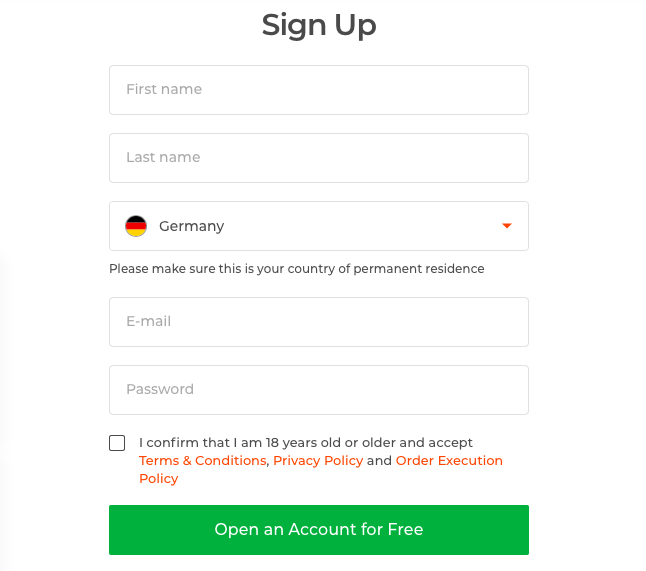
(Risk warning: Your capital can be at risk)
If you find that a broker does not provide the tools, guidance, and support you need to grow and make money, you can choose to do business with another broker.
Step #2: Choose what Options you want to trade
After you use fundamental or technical analysis to speculate what direction the price of an asset will go, you can take on options contracts bearing in mind the following precepts:
- If you believe the price will rise, buy a call option or sell a put option.
- If you believe the price won’t change, sell a call or a put option.
- If you believe the price will fall, buy a put option or sell a call option.
Step #3: Estimate the strike price
An option is only worth something if its price closes “in the money” by the contract’s expiration time. For call options, a price above the strike price is considered “in the money.” The opposite is true for put options. You need to estimate what the strike price will be during your contract’s lifetime.
You can’t just type in any strike price you like. The broker will provide you with “options quotes,” which contain the range of available strike prices. The available prices are based on the asset’s price at any given moment. You also cannot forget that you need to pay a premium, and you must decide whether the risk of losing the premium is worth the potential profit.

Step #4: Work out the time frame
Every options contract expires at some point. Just like you cannot register a custom strike price, you cannot choose just any time frame. You must pick a time frame from the limited options that your broker provides you with.
Options are of two types: American and European
If you hold an American option, you can exercise your option at any point until the expiry of the contract. In contrast, European options can only exercise their option on the day of expiry. Most traders prefer getting their hands on an American-style options contract for the flexibility they offer. But American options contracts are also more expensive than the European kind.
The expiration date of an option can vary from days to years. Long-term investors typically go for options that expire on a monthly or yearly basis. The longer timeframe gives the stock more of a chance to move and make the trader money. Furthermore, these options also offer the benefit of retaining time value, even if the stock trades below the strike price.
That being said, long-term options are a lot more expensive than those with a shorter expiration date.
Daily and weekly options pose a high risk and are only suitable for seasoned traders that know what they are doing.
Options trading strategies
An options trading strategy can be decidedly straightforward or remarkably complex.
There is no right or wrong strategy, and at the end of the day, you must employ strategies that you find effective. What works for you may not work for another trader, and the same is true the other way around. Before we discuss some of the best-known options trading strategies, here’s a quick rundown of the fundamental components of a strategy.

Charts and Patterns
While you make trading decisions by reading the news and researching the underlying asset, the other most reliable way to speculate price movements is to look at charts and patterns. These work on a notion that every trader worth their salt would be compelled to agree with: “history repeats itself.”
Reading a chart, however, is not enough. To gain some perspective and find repeating patterns, you must use indicators. Every strategy uses different indicators, but some of the most commonly used ones are:
- Money Flow Index (MFI) indicator
- Bollinger Bands
- Relative Strength Index indicator
- Open Interest indicator
- Put Call Ratio Indicator
Pattern trading is complicated, and it takes a long time for a trader to become proficient in finding patterns that make money. Over time, you will need to test out different charts and try out various strategies and indicators before finding one that paints you the right picture about an asset’s future.
Timing
Timing the entry and the exit when trading right is only the start. A good trader prepares for the day ahead.
Traders that make living trading options wake up early – typically by 6 am ET – so they can get a feel for where the markets are heading in Europe. They then tailor their strategies according to how their trading market of choice has moved through the morning. The U.S. market opens at 9:30 am ET. It is worth noting that the movement in the U.S. market most often dictates the direction of global markets. You could observe the U.S. markets during the first hour, let it settle, and then begin trading options.
Careful analysis and excellent timing are quintessential to making money trading options. You can only succeed if you put in the hours and spend time improving your skills.
Top Options trading strategies
You can make a profit trading options in endless ways. However, you must gauge the risk, the reward, the capital, and several other factors when deciding which strategy to use.
Most options trading strategies are fairly complicated. We’ve highlighted a few of the easier and more popular ones below.
The Long Call strategy
If you’re confident that the price of a particular asset will go up but want to limit risk, the long call strategy is right for you. Before understanding how the strategy works, you must realize that options are leveraged instruments. One option gives you control over a hundred shares. Let’s suppose a trader invests $10,000 in a company’s stock trading at $100. They will purchase 100 shares with that amount. Let’s say that the price of the stock goes up to $110.
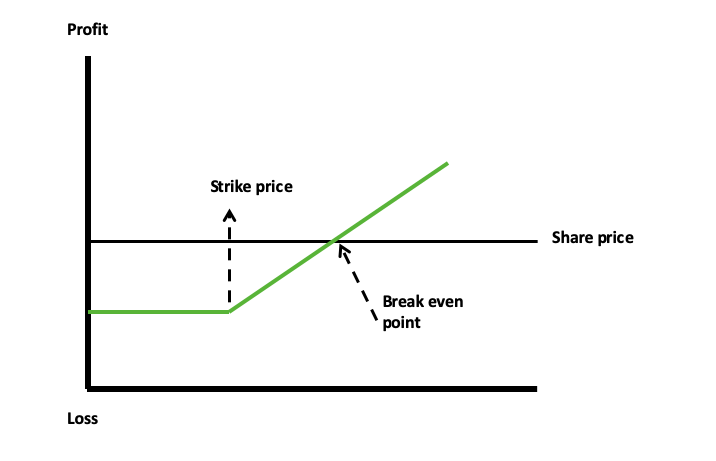
Ignoring the brokerage fees, commission fees, or transaction fees paid, the value of the trader’s portfolio will go up by 10%. They will have made $1000. On the other hand, let’s say that buying an option for the same company’s stock costs $250. With the same $10,000, the trader can buy 40 options contracts. With options, the trader is effectively dealing with 4000 shares.
In the same scenario where the stock price goes up by 10%, the profit the trader could make rises to $440,000. The net profit would be $40,000 since they bought the 4000 shares at $100 and sold them at $110. In this scenario, the profit the trader makes in the same situation goes from 10% to 300%. Theoretically, there is no limit to how much money you could earn with options.
Furthermore, the trader’s loss would be limited to the premium paid if the price doesn’t rise as expected.
The Long Put strategy
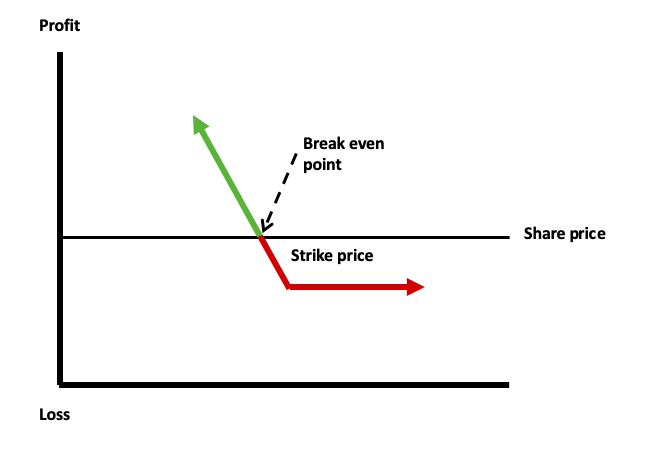
If you’re confident that the price of a particular asset will fall but want to limit risk, the long put strategy is right for you. Unlike the call option, the put option’s price increases as the price of the asset decreases. With a put option, you effectively sell options at a high price and buy them when the price falls.
While you can make money by short-selling the option when the price falls, there is a catch. Short positions put the trader at unlimited risk since there is no limit to how high the price can go. If the asset rises past the strike price, the option becomes worthless. While the potential loss is limited to the premium you pay, the maximum profit you can make is capped – since the price of the asset cannot drop below zero.
The Protective Put strategy
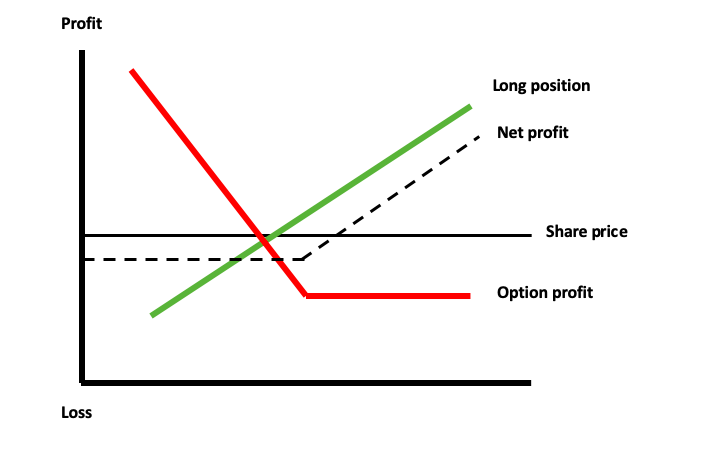
This strategy is similar to the long put strategy and is right for use if you own an asset – a stock, ETF, index, and the like – and want to protect yourself from risk in the short term. As you now know, if the price of the asset rises above the put option’s strike price, the option is worth nothing. The trader loses the premium, but what’s important to note is that the trader benefits from the increase in the asset’s price.
The trader can make their money back and then some by selling the asset. In an alternate scenario where the price of the asset decreases, the trader will lose money. However, the loss is covered by the gain from the put option they own. You can think of buying a put option as an insurance strategy or you can reduce the premium you pay by setting the strike price of the put below the current price of the asset. However, if you do this, you will also decrease the downside protection.
The Covered Call strategy
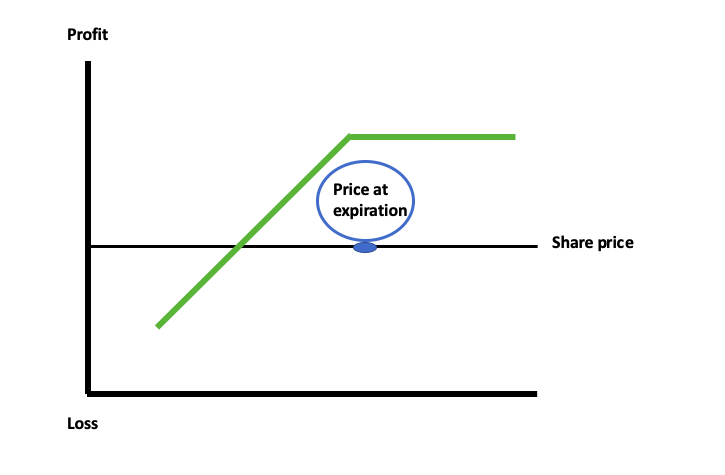
If you’re confident that an asset’s price will not change or increase slightly, you will find the covered call strategy interesting. To use this strategy, though, you must be willing to limit your profit potential in exchange for protection from risk. The covered call strategy involves buying a hundred shares of the underlying asset and then selling a call option against them. When you sell the option, the premium will lower the cost basis of the shares and provide limited protection from risk.
However, by selling the option, you agree to sell the shares off at the strike price, limiting the profit you can make with the option.
Selling Iron Condors
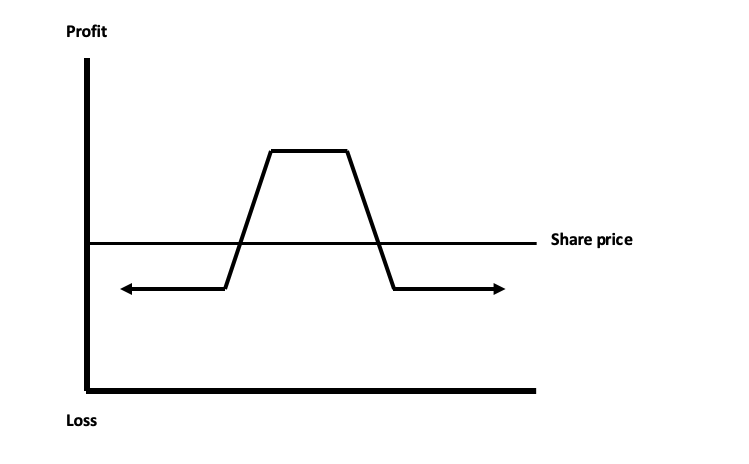
Both conservative and risk-hungry traders can use this strategy. Using this strategy, you can profit whether the asset’s price goes up and down. The profit potential is high. It involves selling a put and buying one at a lower strike price. In other words, you must make a put spread.
The put spread must be combined with a call spread, which involves buying a call and selling one at a higher strike price. The idea here is, as long as the price of the asset stays between the two puts or calls, you will make money. The iron condor strategy is popularly used when the market is volatile. However, you will lose money if the price rises or drops significantly. For this reason, the iron condor strategy is called a market-neutral strategy.
Straddles and Strangles
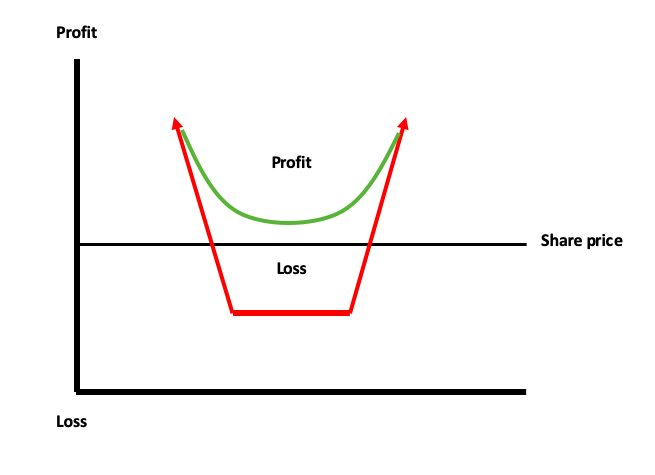
Let’s say you find out that the price of an asset will be volatile – and you don’t know what direction the price is going to go. Perhaps it’s a tech company’s stock, and they’re about to make an announcement. The straddle strategy requires you to buy a call and a put at the same price. The two should have the same expiry date and underlying price as well. Regardless of if the price rises or falls, you will make a profit.
The strangle strategy is similar to the straddle strategy. You must buy an “out of money” call and put for the same price with the same expiry date. The strangle tactic is a lot safer, since you only need the price to move higher or lower than the premium price. The reduced risk is only one of the benefits of this strategy. “Out of money” options are cheaper to buy, making it a low-cost investment strategy that’s also effective.
Common Options trading mistakes
Even the best traders make mistakes. Knowing what you can do wrong before you start trading is one of the best ways to grow as a trader. One of the most common mistakes that options traders make is holding onto their option until the expiration date. If you see that the asset’s price has increased or down drastically, go ahead and reap the gains – even if you have a year left on the contract.
A lot of traders, especially beginners, forget to make a good exit plan. You must know to exit an option if you’ve suffered a loss or if you’ve made the profit you wanted to make. Another common mistake is trading with the “cheaper is better” mindset. This isn’t necessarily true for options. If you get an “out of money” option, while you will invest less, the trade will be riskier, and the profit potential will be a lot lower.
Tips for trading Options
While strategies and techniques will take you a long way, you can always up your game with some tried and true tips. We’ve highlighted some top tips below:

Education
Educating yourself can bring about an immense change in your trading. Read every resource you can find. The best traders are always hunting for and consuming information about the market.
Some resources you can benefit a lot from include:
- Trading books
- Free eBooks and PDFs
- Courses
- Blog posts
- Podcasts
- Forums
Staying in the loop by reading the news also helps with making better trading decisions and finding new opportunities for profit.
Risk management
Regardless of if you’re planning to trade weekly or yearly options, you must have a risk management technique. Minimize your losses and ensuring you never hit rock-bottom are essential skills. The 1% rule is the go-to risk management technique for most traders. If you have $10,000 in your trading account, never risk more than 1% on a single trade.
If you find yourself making money consistently, you can increase the risk you take to 2% or even 5%.
Demo accounts
If you’re eager to begin investing in options and making money, we advise you to slow down and gain some experience using a demo account. After you’ve gotten a grip over some strategies and see that you’re consistently making money with your demo account, you can go ahead and invest real capital.
Practicing first will not only help you find and fix your weaknesses, but it will also allow you to test out your broker’s platform.
Summary: Trading options is worth it but difficult at first
Trading options isn’t easy – but now that you’ve read our guide, you’ve taken your first steps of making money with them. Never stop learning, and if you feel uneasy trading or trying out a new strategy, use a demo account until you feel comfortable. All that’s left for you to do is tackle the market and gain some experience. There’s no shortage of money to be made.
FAQ – The most asked questions about Options trading :
Can options trading become a full-time job?
People often take trading as a profession that provides a high barrier to entry. But, if a person has the right level of ambition, patience, and courage, they can make a living out of just trading, even with just a small amount of money. You can choose to do trading as your full-time career, as a part-time job along with your main job, or even just as a hobby for you to learn and pursue.
How much time is needed to completely understand options trading?
For a person to learn options trading from scratch, they need to completely grasp the theory of options trading first, and then they would need to practice and understand the placements of orders. A person should also try their hand at trading through demo accounts before they finally climb up the ladder, and then finally, they can get their live accounts and start trading. Throughout this process, a person usually takes 3 to 6 months to learn options trading.
Is options trading risk-free?
No, in any type of trading, risk is always involved. In the case of an option buyer, they pay a premium that benefits them with limited risk and limited losses, but unlimited losses have also been observed in the case of option sellers. If you play your cards right, options trading can reap huge benefits for you. But it also involves great risks if you fail.
See our similar blog posts:
Last Updated on January 27, 2023 by Arkady Müller

 unsplash.com
unsplash.com